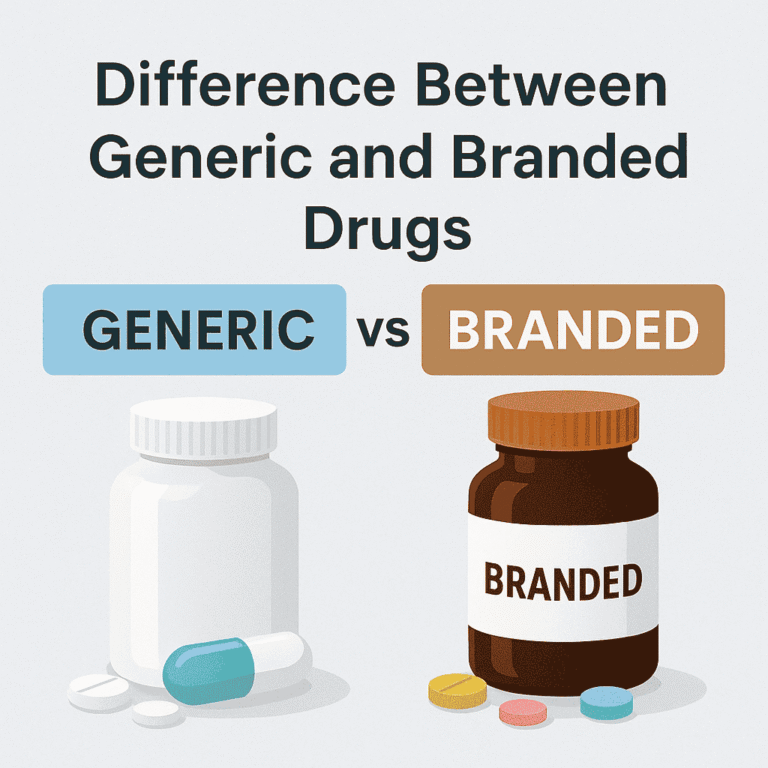The pharmaceutical market is broadly categorized into two segments—branded drugs and generic drugs. While both serve the same therapeutic purpose, there are key differences in cost, development, marketing, and regulation that set them apart.
This blog explains the differences between generic and branded drugs, covering composition, bioequivalence, safety, cost, manufacturing, and approval process, based on the Drugs & Cosmetics Act and global regulatory guidelines.

What Are Branded Drugs?
Branded drugs (also known as innovator or pioneer drugs) are those that are:
Discovered and developed by a pharmaceutical company.
Patented for exclusive sales and marketing.
Backed by extensive clinical trial data to prove safety and efficacy.
Example: Lipitor® (atorvastatin) developed by Pfizer
These drugs are usually protected under a patent for 20 years, preventing other manufacturers from producing or marketing the same molecule during that period.
What Are Generic Drugs?
Generic drugs are chemically identical versions of branded drugs that:
Enter the market after patent expiry.
Contain the same active ingredient, strength, route, and dosage form.
Must demonstrate bioequivalence to the branded version.
Example: Atorvastatin tablets manufactured by Cipla or Sun Pharma as a generic version of Lipitor.
Branded vs Generic Drugs: Key Differences
| Parameter | Generic Drugs | Branded Drugs |
|---|---|---|
| Definition | Drugs equivalent to branded ones in dosage, safety, strength, route, and efficacy | Original products developed and patented by pharmaceutical companies |
| Active Ingredient | Same as branded drug | Proprietary composition but contains same active molecule once generic is made |
| Excipients | May differ from branded drug | Specific formulation with unique excipients |
| Cost | Much lower (up to 80-90% cheaper) | Higher due to R&D, marketing, and branding |
| Patent Protection | No patent; launched after branded patent expires | Patent-protected (usually 20 years) |
| Approval Requirement | Requires bioequivalence and stability data | Requires full clinical trial data and regulatory approval |
| Time to Market | Faster, post-patent expiry | Takes years due to lengthy R&D and clinical phases |
| Bioequivalence | Must demonstrate bioequivalence to branded drug | Not required (already originator) |
| Brand Recognition | Low brand recall among general public | High recognition and physician preference |
| Promotion/Marketing | Minimal, mostly through doctors and government programs | Extensive marketing to doctors and consumers |
| Manufacturer | Multiple generic drug companies | Only the innovator company initially |
| Example (India) | Paracetamol (by Jan Aushadhi) | Crocin |
| Labeling & Packaging | Plain and standard packaging | Professionally designed, branded packaging |
| Quality & Efficacy | Same therapeutic outcome if approved by CDSCO/USFDA/WHO | Established efficacy through R&D studies |
| Regulatory Approval Body | CDSCO (India), USFDA (USA), EMA (Europe) | Same regulatory bodies but stricter approval for new molecules |
Differences in Manufacturing Standards
Both generic and branded drugs in India are required to follow Good Manufacturing Practices (GMP) under Schedule M of the Drugs & Cosmetics Rules. However, inactive ingredients, colorants, and binders may differ, which can affect appearance, taste, or shelf-life, but not therapeutic efficacy.
What Is Bioequivalence?
Bioequivalence ensures that the generic drug releases the same amount of active substance in the bloodstream in the same time frame as the branded drug. Parameters tested include:
- Cmax (maximum plasma concentration)
- Tmax (time to reach Cmax)
- AUC (area under the curve)
In India, CDSCO mandates bioequivalence studies under Schedule Y, supervised by DCGI.
Why Are Generic Drugs Cheaper?
Generic manufacturers save on:
- Research & Development (already done)
- Clinical trials (not needed)
- Promotional marketing (minimal branding)
Hence, they are sold at significantly lower prices, increasing accessibility and affordability of healthcare, especially in developing countries.
According to WHO, the widespread use of generics can save 30–70% of drug expenditure.
Legal and Regulatory Framework
In India:
- Governed by the Drugs & Cosmetics Act, 1940
- Approval from CDSCO via Form 44 (generic) and New Drug Application (branded)
- State FDA issues the manufacturing license
Globally:
- US FDA regulates generics under the ANDA (Abbreviated New Drug Application)
- EMA (Europe) follows a similar bioequivalence-based model
Which Is Better: Branded or Generic?
| Criteria | Verdict |
|---|---|
| Efficacy | Comparable |
| Safety | Equivalent |
| Cost | Generic is better |
| Brand trust | Branded has recognition |
So unless medically advised otherwise, generic drugs are equally effective and far more cost-efficient.
📌 Also Read: How Generic Drugs Are Approved in India: A Complete Guide.
Conclusion
Both branded and generic drugs play important roles in healthcare. While branded drugs represent innovation and discovery, generics ensure cost-effective access to essential medications after patent expiry. Regulatory mechanisms ensure that both meet high standards of safety, efficacy, and quality.
Whether you’re a pharmacy student, healthcare provider, or patient, understanding this distinction helps you make informed decisions in clinical practice and policy.
💬 Have questions or insights? Drop them in the comments!
